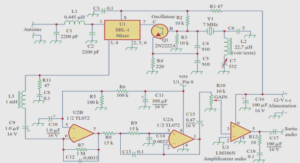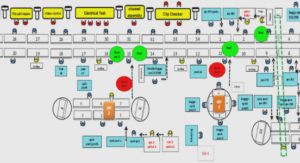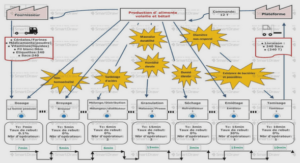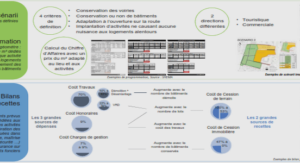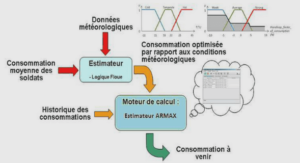Descriptive statistics for mineralogical constituents and ratios of the studied ferralitic
Mean first derivative spectrum of the whole data set and three individual spectra in the 2150-2350 nm range. P1: peak of maximum reflectance of kaolinite, between 2212-2214 nm; P3: peak of maximum reflectance of gibbsite, between 2272-2284 nm; P2: point of minimum reflectance between P1 and P3, situated between 2234 and 2248 nm; P2*: intersection point of the spectra, situated between 2256 and 2268 nm. The descriptive statistical analyses of mineralogical characteristics of the soils are shown in Table 1. On average, aluminium was the major element (197 ± 83 g kg-1 Al2O3_SA), followed by silicon (142 ± 69 g kg-1 SiO2_SA) and iron (80 ± 49 g kg-1 Fe2O3_SA). However, a large variability was observed among the studied soils (Fig. 3a). The mean Ki and Kr ratios, calculated from the SA extraction results, were 1.5 and 1.1, respectively. According to the CPCS (1967), the soils are classified as ferrallitic when Ki < 2. Therefore, 32 soil samples of the 148, including 3 Ferralsols, were not correctly classified based on field observations (Ki > 2). Kaolinite was the dominant mineral of the clay fraction (305 ± 148 g kg-1) (Table 1 and Fig. 3b). Crystalline iron oxides, estimated by the CBD extraction (Fe2O3_CBD), accounted for 43 ± 30 g kg-1. The amount of Al2O3 in the kaolinite was 227 ± 110 g kg-1.
whereas the amount of Al2O3 substituted in the iron oxides was 12 ± 12 g kg-1. The chemical estimation of Al substitution of iron oxides was 33%, i.e. nearly the maximum theoretical Al substitution ratio (Cornell and Schwertmann, 1996). The goethite and hematite contents, calculated from the iron oxide content and Al substitution ratio, were 34 ± 26 g kg-1 and 12 ± 18 g kg-1, respectively. The gibbsite content, calculated from the remaining amount of Al2O3, was 98 ± 131 g kg-1. The mean RKGb ratio, calculated from the kaolinite and gibbsite contents, was 0.75 ± 0.25.Al2O3_CBD: the amount of Al substituting Fe in iron oxides determined by the citrate-bicarbonate-dithionite (CBD) deferrification method; Fe2O3_CBD: the amount of Fe determined by the CBD method; SiO2_SA: the amount of silicon determined by the sulfuric acid extraction method (1:1 deionized water/cc. sulphuric acid; SA); Al2O3_SA: the amount of aluminium determined by the SA method; Fe2O3_SA: the amount of iron determined by the SA method; Ki: SiO2_SA/Al2O3_SA; Kr: SiO2_SA/(Al2O3_SA + Fe2O3 _SA); Kaolinite, Gibbsite, Goethite and Hematite calculated according to Eqs. 1 to 4; RKGb: Kt/(Kt + Gb); SD: standard deviation.
NIR calibration and validation of mineralogical properties with chemometric methods
The predictions of mineralogical properties of soils using chemometric methods were poorly effective (Table 2). Only Al2O3_SA and Fe2O3_CBD were satisfactorily calibrated, according to the classification of Chang et al. (2001) and Malley et al. (2004), with R2 cv = 0.74 and 0.80 and RPDc = 2.0 and 2.2, respectively. All the other mineralogical properties were moderately calibrated (RPDcv between 1.4 and 1.7). External validations also yielded poor results (RPDv < 2). In the case of kaolinite and gibbsite, the values for the validation set are markedly lower than those of the calibration set (R2 v = 0.37 and 0.51 and RPDv = 1.3 and 1.4, respectively).Pre-treatment: MSC: Multiplicative Scatter Correction; NONE: no treatment; SNV: Standard Normal Variate. The numbers indicate the derivatives (0, 1 and 2: no derivation, first and second derivatives, respectively); number of point gap (0, 4, 5, 10); number of point for first smoothing (1, 4, 5, 10); and number of point for second smoothing (1); N: total number of samples; out: number of outliers; n1: number of samples in the calibration set (N – out); n2: number of samples in the validation set; Mean: mean of calibration or validation sets; SD: standard deviation; SECV: Standard Error of Cross Validation; R²c: coefficient of determination of SECV; RPDc: Ratio Performance Deviation (SD/SECV); SEP: Standard Error of Prediction; R²v: coefficient of determination of SEP. The abbreviations for the mineralogical constituents and ratios are specified in the footnote.
NIR calibration and validation of specific spectral peaks for kaolinite and gibbsite
The PLS loadings of the soils spectra (Fig. 4) were analysed after the best pre-treatments made for the four analyzed minerals (Table 2), i.e. NONE 0011 for gibbsite, NONE 2441 for kaolinite, SNV 210101 for goethite and NONE 210101 for hematite. The loadings corresponding to the NONE 0011 pre-treatment had a specific shape with weak and monotonous changes for PC1 and PC2 and a marked peak at nearly 2265 nm for PC3 (Fig. 3a.). For the three other pre-treatments the three loadings were closely identical, with high loadings at 1 350-1 550, 1 850-1 950 and 2 100-2 500 nm (Fig. 4b, 4c, 4d). The most specific spectral bands produced by the studied minerals in the near-infrared range were situated between 2 200 and 2 300 nm. The peak of gibbsite was clearly detected at nearly 2 270 nm with the NONE 0011 pre-treatment, whereas both kaolinite and gibbsite peaks were detected using the NONE 2441 pre-treatment, at nearly 2 205 and 2 270 nm, respectively (Fig. 4b.). Some specific loadings were observed for PC3 at 1 650-1 800 nm with the SNV 210101 pretreatment that corresponds to the best pre-treatment for goethite (Fig. 4c.). The correlation, obtained by linear regression between kaolinite content and intensities of its specific absorption peaks (IKt), and by polynomial regression, between gibbsite content and intensities of specific absorption peaks (IGb) are shown in Fig. 5. The coefficients of determination were satisfactory for kaolinite and gibbsite, with adjusted R²c = 0.69 and 0.71, respectively (Fig. 5.). These coefficients are higher than R2 c values obtained for kaolinite and gibbsite (0.60) by partial least square regressions (Table 2). The values obtained for the validation set (R2 v = 0.72, for both kaolinite and gibbsite) are also similar to those of the calibration set.

